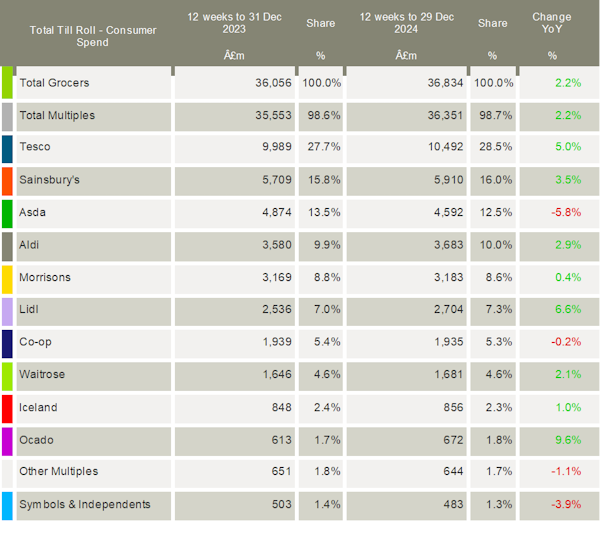Latest industry data from Kantar confirms that Tesco, Sainsbury’s, Lidl, and Ocado were the winners at Christmas, while Asda remained the laggard.
Overall take-home sales at UK grocers rose by 2.1% over the four weeks to 29 December compared with last year, with average household spending on groceries during the period hitting a record high of £460. However, grocery price inflation ticked up to 3.7%, its highest level since March 2024.
“It was a solid Christmas at the supermarkets with sales surpassing £13bn during the four weeks of December for the first time ever, showing people were clearly in the mood to celebrate and spend,” said Fraser McKevitt, head of retail and consumer insight at Kantar.
“In contrast to reports of disappointing footfall across the rest of the high street, it was a very different story in the world of grocery. The average household made nearly 17 separate shopping trips this December, delivering the busiest month since the pre-lockdown rush in March 2020. As anticipated, Monday 23 December was the most popular shopping day of the year, with sales a whopping 30% higher than any other day during 2024.”
After a difficult year for many households, data shows people splashed out a bit more than usual during the festive season, with sales growth for branded goods accelerating to 4.2% and premium own-label lines jumping 14.6%. The latter accounted for a record 7.0% of all sales, as nine in 10 households bought at least one of these products in December.
Looking at the performance of individual retailers, Tesco saw growth across its convenience, superstore and online channels, with sales over the 12 weeks to 29 December up 5.0%. Its 0.8 percentage point share gain was the biggest of any supermarket, taking its hold of the market to 28.5%.
Sainsbury’s achieved its highest share since December 2019 at 16.0% after its sales growth of 3.5% outpaced the market. Despite its recent turnaround efforts, Morrisons had a relatively disappointing period, with sales growth of just 0.4%. Meanwhile, Asda continued its poor run, with its market share sliding from 13.5% to 12.5% after a 5.8% fall in sales.
Lidl and Aldi achieved their highest-ever Christmas shares at 7.3% and 10.0% respectively. Lidl secured the fastest footfall growth of any retailer as spending through its tills increased by 6.6%. However, Aldi’s sales were only up 2.9% despite attracting an additional 315,000 shoppers to its stores.
Meanwhile, online grocery spending in December reached a record £1.6bn, with Ocado seeing its sales climb 9.6% over the 12 weeks.
Kantar also provided some insight into the performance of M&S, whose higher proportion of clothing and general merchandise in its sales mix means it does not fall under the definition of ‘grocers’ using the research group’s Till Roll methodology. Looking at just food and drink spending, sales at M&S increased by 8.7%, driven by strong performance in its core fresh and chilled range (9% higher) and ambient lines (11% greater).

NAM Implications:
- Clearly, consumers that could, were determined to celebrate Christmas, foodwise…
- …in spite of pipeline issues arising from the Autumn Budget.
- Meanwhile, variances in retailer performance enables suppliers to check for achievement of fair share of sales.
- Tesco, Sainsbury’s and Ocado performed as or better than expected…
- …whilst suppliers will probably be even more cautious re active support for Asda and Morrisons in 2025.
- Meanwhile, questions arise re. the discounters:
- How would their performance appear if like-for-like figures were available?
- How long will global Aldi and Lidl allow their UK operations to invest in new outlets and price support at local level?
- How will the discounters fare/respond as Retail Media revenues play an increasing element in rivals’ profitability?



